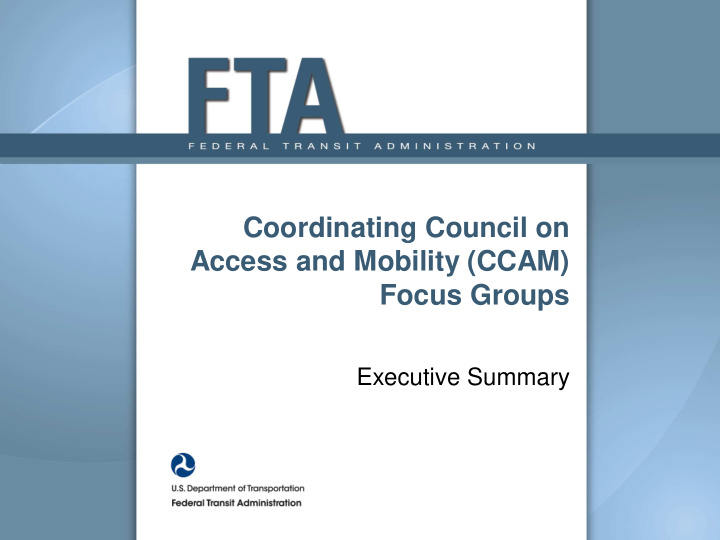



Coordinating Council on Access and Mobility (CCAM) Focus Groups Executive Summary
CCAM Overview The Coordinating Council on Access and Mobility (CCAM) is an interagency partnership established in 2004 by Executive Order to coordinate the efforts of the federal agencies that fund transportation services for targeted populations. Mission The CCAM issues policy recommendations and implements activities that improve the availability , accessibility , and efficiency of transportation for the following targeted populations: People with Older Adults Individuals Disabilities of Low Income Vision Equal access to coordinated transportation for all Americans 2
CCAM Strategic Framework Overview In response to the CCAM’s congressional mandate in the Fixing America’s Surface Transportation (FAST) Act, representatives of CCAM member agencies met in 2016 and 2017 to create a framework for the CCAM strategic plan. The outcome was the CCAM Strategic Framework, which is summarized below. Goal 1: Improve Access to the Goal 2: Enhance Cost-Effectiveness Community through Transportation of Coordinated Transportation • • Objective 1: Reduce federal policy barriers Objective 1: Enable equitable cost to coordinated transportation sharing among state and local • stakeholders Objective 2: Increase state and local • transportation coordination Objective 2: Develop framework for • transportation cost reporting Objective 3: Promote public aware- • ness of available transportation Objective 3: Promote the adoption options of cost sharing CCAM Goal 3: Strengthen Interagency Goal 4: Demonstrate Future Goals Partnerships and Collaboration Models for Coordinated with State, Local, and Industry Transportation Groups • Objective 1: Implement and • evaluate CCAM pilot programs Objective 1: Refresh the CCAM • Objective 2: Incorporate the use Operating Model of innovative technologies in • Objective 2: Coordinate transportation coordinated transportation initiatives for targeted populations • Objective 3: Expand opportunities for external input 3
Focus Group Objectives and Outputs To further address FAST Act requirements, the DOT convened state and local focus groups with CCAM stakeholders to achieve the following objectives and outputs. Outputs Objectives Understand the current state of transportation Documented transportation coordination baselines services for target populations for CCAM stakeholder groups Identify transportation coordination success Documented state and local promising practices stories and promising practices and lessons learned Catalogued policies and practices that hinder local Identify barriers to transportation coordination transportation coordination FAST Act Requirements Addressed by Focus Groups Address outstanding recommendations made by the Council including a cost sharing policy and recommendations to increase grantee participation in coordinated planning processes To the extent feasible, address outstanding recommendations made by the Comptroller General concerning local coordination of transportation services Propose changes to federal laws and regulations that will eliminate barriers to local transportation coordination, including nonemergency medical transportation 4
Focus Group Participants The facilitation team engaged over 200 stakeholders from 22 different states, using a variety of focus group formats. The map below identifies stakeholder locations and is overlaid by the DOT regions. 5
Focus Group Findings The following barriers emerged across a majority of focus group sessions and stakeholder groups as the most prevalent barriers to transportation coordination. Rank Barrier Definition A lack of awareness of the federal funding sources available for human Limited 1 service transportation, the policies that enable transportation coordination, Awareness and/or the community's transportation options for targeted populations Unengaged Challenges associated with establishing and maintaining the organizational 2 Stakeholders and community partnerships necessary to pursue transportation coordination Reporting obligations, eligibility criteria, trip purpose restrictions, and other Program 3 program rules that make it difficult to coordinate across different transportation Restrictions programs Insufficient A lack of incentives or financial motivation for human service providers to 4 Incentives pursue transportation coordination initiatives Limited An absence of federal guidance that states and local communities need to 5 Federal coordinate transportation in compliance with federal law Guidance 6
Focus Group Findings (cont’d) The following barriers emerged across a majority of focus group sessions and stakeholder groups as the most prevalent barriers to transportation coordination. Rank Barrier Definition City, county, or other regional lines that define an organization's service area Jurisdictional 6 and prevent that organization from coordinating with other entities beyond the Boundaries service area The accounting obligations, logistical responsibilities, implementation work, Administrative 7 and other administrative tasks that consume an excessive amount of time and Burden resources. A lack of the data that states and local communities need to increase the Insufficient transparency of transportation spending, demonstrate the utility of 8 Data transportation coordination, and allocate the costs of coordinated transportation equitably Apprehension about sharing the costs of coordinated transportation across Cost Sharing 9 participating stakeholders in a way that is equitable and proportionate to the Concerns services received. Transportation vehicles and facilities that funding recipients cannot use for Inaccessible 10 some coordination activities because they are inaccessible to people with Systems functional limitations 7
Coordination Barriers by Stakeholder Group The figure below outlines the coordination barriers that emerged as themes within each stakeholder group. 8
Next Steps Findings from the focus groups will inform the current phase of federal work groups and the development and refinement of CCAM recommendations. 1. CCAM federal work groups develop policy and non-policy recommendations to address barriers identified by focus groups 2. Congress uses policy recommendations to change federal law 3. Agencies use non-policy recommendations to change federal guidance End Result Coordinated transportation improves efficiency and availability 9
Recommend
More recommend